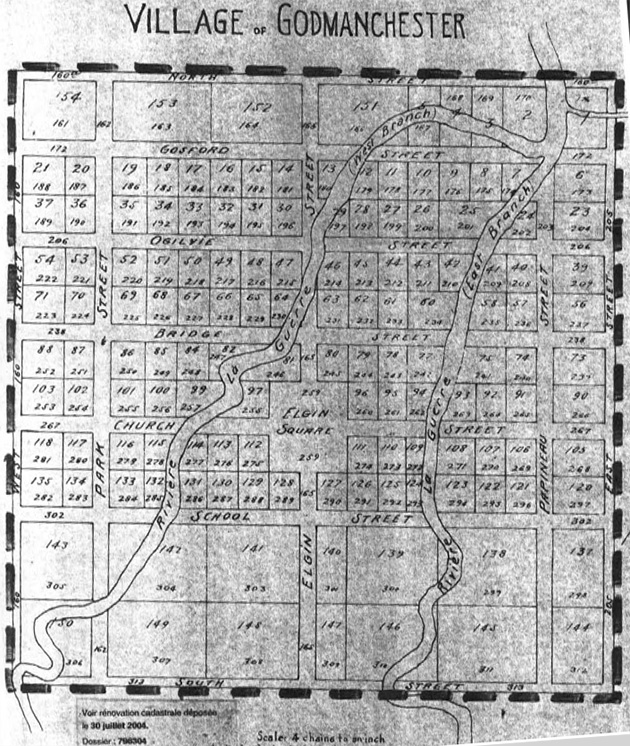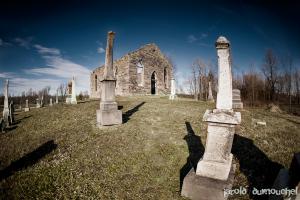In 1892 begins the construction of the St. Andrew's church in this small village somewhere in Gaspésie. While the land was formerly occupied by the Mi'kmaq, the region was soon settled by Scots in the nineteenth century followed by Irish, English...
The abandoned village of Rivière-La Guerre
Back to the future... I mean the past
Even if the term "abandoned village" applies to this little hamlet that was Rivière-La Guerre, I must admit that there is today not a lot of vestiges to testify the presence of this old Scottish village. This village has lived, after all, only thirty years.
The name Rivière-La Guerre takes its origin from François dit La Guerre who lived in the region at the beginning of the nineteenth century.
It is from the mid-1820s that came the first Scottish settlers in the village of Godmanchester, better known as Rivière-La Guerre. In 1830, the village has 82 inhabitants divided into 16 families. A schoolhouse was in operation from 1829 to 1846 and several shops, including a shoemaker, opened their doors.
The territory organizes itself slowly and will be divided into 144 lots in 1847, including a dozen who will become the property of the Calvin Presbyterian Church. Moreover, on the plan displayed bellow, we can see few streets and a public square. While some of these streets will be started, including the public, the work will unfortunately never be completed. Today, there is a dirt road instead of the Elgin Street.

By superimposing the Google map today plan above, we find that the last vestiges, namely, the church and the presbytery (both abandoned) were respectively located on lots 94, 93 and 92 (the presbytery seems be located on two lots). As for him, the Manor Rosebank seemed to occupy the lot 127. Of course, these assumptions are hypothetical and manipulation have been made in Photoshop.
The village will live about thirty years. In the late 1850s, it was practically deserted. Flooding caused by the construction of the first Beauharnois Canal will cause desertion of the village and its inhabitants. In addition, Durham boats who had been able to navigate many of the area's small rivers can't come to the village anymore. These boats were being replaced by steam-powered vessels capable of only navigating the lake. So the wharfs of LaGuerre became useless in favour of the deeper water found less that five miles away at St. Anicet's lake shore. The buildings that made up LaGuerre Settlement were gradually abandoned, left to erode, and then to disappear.
The Rosebank manor
Built around 1840, the Rosebank or John MacDonald manor is now the only vestige still inhabited in the former village. It's also the family who began to buy lots of the town in the late 1840s. Today, all land that once formed the village belonged to the descendants of the Irving family who in 1914 bought the manor from the MacDonald family.
The church and the cemetery
It is about 80 graves lies in the cemetery of the Calvin Presbyterian Church. The last funeral, that of a certain Harry Steward, dates back to 1948. Today, the cemetery is in very poor condition and many tombstones have fallen or threatens to do so.
In regard to the church, the time has largely damaged its facade. The roof fell at the turn of the new millennium, its walls crumbling and vegetation began to grow within its four walls.
In 1847, the first foundation stone of "The Free Presbyterian Church of LaGuerre" was laid by John Leslie. With the help of the other founding families, the church was completed in 1851. The church provided services in English and Gaelic.
Ironically, it was during the construction of the church that the Village of LaGuerre began its decline. Although the membership was never large, Calvin Presbyterian Church continued to be used for regular services until 1931. The church was among those that were part of the 1925 amalgamation of the Methodist and Presbyterian Churches into the Canadian United Church. Services were held with some frequency until 1939 -- and the last service held in 1941. The building was then used infrequently by local community groups until the contents were dispersed.
The presbytery
Located on the other side of the river, the red brick building is also in fairly advanced state of neglect. The structure is still in better shape than the church. The construction, although unknown, probably dates back to the mid-1850s. His life will be very short because utlise 1857, no pastor lies in the village permanently. The presbytery will still used sporadically, but quickly fall into oblivion.
Sources:
- Le village abandonné de Rivière-La Guerre. Étude comparative - Par Guy Mongrain et Claire Poitras
- Calvin Presbyterian Church & LaGuerre Cemetery
Related content
Closed in 2013, this church located along the highway has today a very sad mine. From the outside, a section of its stone wall presents risks of collapse and inside, the passage of many vandals is no doubt.
Located in an old village on the...
Built in 1895, the Beaver Creek Free Methodist Church is almost abandoned. Even if the church is actually still in use a few weeks of the year, the place is abandoned for the rest of the year.
Desolate and alone, it stands in perfect...
Despite the many changes made to the building by the Negro community center, it is clear that the original building was a church. Plans are signed by Sidney Rose Badgley (1850-1917), an architect from Ste.Catherine,...































